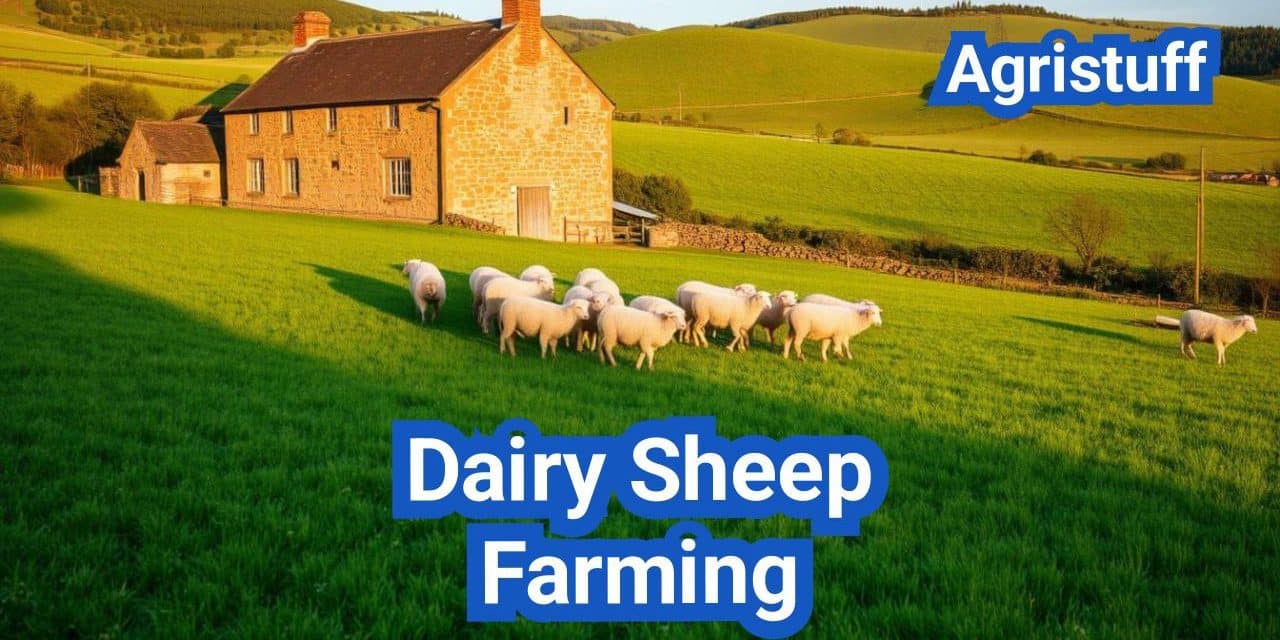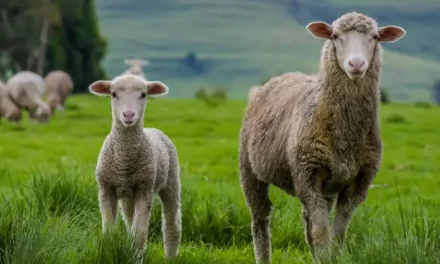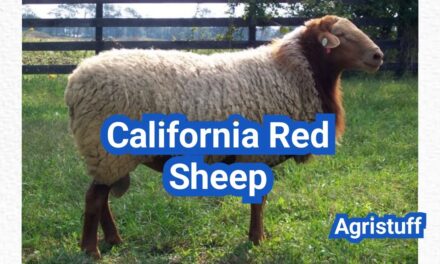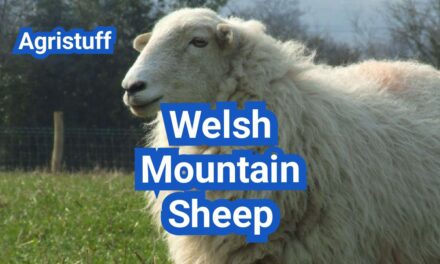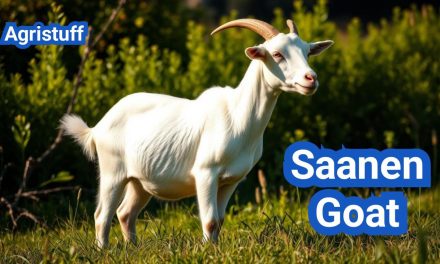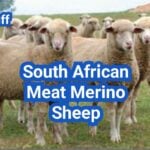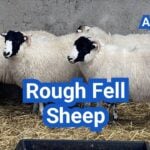Dairy sheep farming is a unique and rewarding venture that offers numerous benefits, including the production of high-quality milk and dairy products.
For those new to this field, understanding the basics of sheep farming, including breeds, feeding practices, and milking techniques, is crucial for success.
This comprehensive guide will cover all aspects of dairy sheep farming, providing valuable insights for those looking to start or expand their operations.
Key Takeaways
- Understanding the basics of sheep farming is crucial for beginners.
- Dairy sheep breeds vary in milk production and quality.
- Effective feeding practices are essential for optimal milk production.
- Milking techniques impact the quality and quantity of milk produced.
- Dairy sheep farming offers a sustainable and profitable farming option.
The World of Dairy Sheep Farming
Dairy sheep farming combines traditional practices with modern techniques to produce high-quality milk. This unique agricultural sector is gaining attention globally due to its potential for producing nutritious dairy products.
Sheep milk is renowned for its high nutritional value, rich in vitamins, minerals, and healthy fats. It is particularly prized for its use in cheese and yogurt production.
What Makes Sheep Milk Unique
Sheep milk stands out due to its composition, which includes higher levels of fat and protein compared to cow or goat milk. This makes it ideal for producing rich, creamy dairy products.
- High in conjugated linoleic acid (CLA)
- Rich in vitamins A, B, and E
- Contains higher levels of calcium and phosphorus
Comparing Sheep, Cow, and Goat Dairy Operations
Each type of dairy operation has its unique advantages and challenges. Sheep dairy farming is often compared to cow and goat dairy farming in terms of milk production, management practices, and market demand.
| Dairy Type | Milk Production | Management Practices |
|---|---|---|
| Sheep | High fat content, rich in nutrients | Requires specific breed knowledge, intensive care |
| Cow | Large volume, versatile products | Needs extensive pasture or feed management |
| Goat | Easier to digest, diverse product range | Less land-intensive, adaptable to various climates |
Current State of the Sheep Dairy Industry
The sheep dairy industry is experiencing growth, driven by consumer demand for specialty dairy products. Trends include an increase in artisanal cheese production and a focus on sustainable farming practices.
- Increasing demand for sheep milk products
- Advancements in dairy sheep breeding programs
- Growing interest in sustainable and organic farming
Why Consider Dairy Sheep Farming

The appeal of dairy sheep farming lies in its multifaceted benefits, ranging from economic advantages to environmental sustainability. This form of agriculture offers a unique blend of opportunities for farmers, particularly small landholders.
Economic Advantages for Small Landholders Of Dairy Sheep Farming
Dairy sheep farming provides several economic benefits, making it an attractive option for small-scale farmers. One of the primary advantages is the diversification of income streams. Farmers can generate revenue not only from milk sales but also from the sale of wool, lamb meat, and even breeding stock. This diversification can help stabilize farm income and reduce dependence on a single commodity.
Low maintenance costs are another economic advantage. Sheep require less intensive care compared to some other livestock, potentially reducing the overall cost of operation. Moreover, the initial investment in dairy sheep can be relatively manageable, especially when compared to larger dairy operations.
Environmental Benefits and Sustainability
Dairy sheep farming is also recognized for its environmental benefits. Sheep grazing can contribute to land management by maintaining open spaces and promoting biodiversity. When managed properly, sheep can help control weeds, improve soil health through their grazing patterns, and enhance ecosystem services.
The sustainability of dairy sheep farming is further underscored by its potential to utilize marginal lands that might be less suitable for other forms of agriculture. This aspect makes it particularly appealing for regions with challenging terrain or land that is not prime for intensive crop production.
Regional Suitability Of Dairy Sheep Farming
Certain regions are particularly well-suited for dairy sheep farming due to their climate, pasture conditions, and existing agricultural practices. For instance, Ireland’s mild climate and lush pastures make it an ideal location. Similarly, specific regions in the United States, with their varied landscapes and climates, offer suitable conditions for dairy sheep farming.
Farmers in these regions can capitalize on the local advantages, such as abundant grazing land and a tradition of sheep farming, to establish successful dairy sheep operations. Understanding the local conditions and how they align with the needs of dairy sheep is crucial for the success of such ventures.
Top Dairy Sheep Breeds for Beginners
For those new to dairy sheep farming, selecting the right breed is crucial for success. The choice of breed can significantly impact milk production, ease of management, and overall profitability.
The dairy sheep industry is home to several breeds renowned for their milk production capabilities and hardiness. Understanding the characteristics of these breeds is essential for beginners to make informed decisions.
East Friesian: The High Producer
The East Friesian breed is considered one of the best dairy sheep breeds due to its high milk production. Originating from Europe, this breed is known for its ability to produce large quantities of milk, making it an attractive choice for dairy farmers.
East Friesian sheep are often used in crossbreeding programs to improve milk production in other breeds. Their high milk yield and relatively calm nature make them a popular choice among dairy sheep farmers.
Lacaune: The French Classic
The Lacaune breed, originating from France, is another popular dairy sheep breed. It is known for its high milk production and is often used in dairy operations. The Lacaune breed has been developed over centuries for its dairy capabilities.
Lacaune sheep are recognized for their robust health and adaptability to various farming conditions. They are a favorite among dairy sheep farmers due to their productivity and resilience.
Awassi: Middle Eastern Resilience
The Awassi breed, hailing from the Middle East, is known for its hardiness and adaptability to challenging environmental conditions. While its milk production may not be as high as some other breeds, its resilience makes it an attractive option for farmers in harsh climates.
Awassi sheep are well adapted to extensive grazing systems and can thrive in conditions where other breeds might struggle. Their ability to produce milk under less favorable conditions is a significant advantage.
Crossbreeds for American Conditions
Crossbreeding is a common practice in dairy sheep farming, especially in the United States. By crossing breeds like East Friesian with other local or hardy breeds, farmers can develop animals that are well-suited to their specific regional conditions.
Crossbreeds can offer a balance between high milk production and the hardiness needed to thrive in local climates. This approach allows farmers to tailor their flock’s genetics to their specific operational needs.
Milk Production Expectations

The success of a dairy sheep farming operation heavily relies on the farmer’s understanding of milk production expectations. Dairy sheep typically have a milking period of about six months, during which the quantity and quality of milk can vary significantly based on several factors.
Average Yields by Breed Of Dairy Sheep Farming
Different dairy sheep breeds have varying levels of milk production. For instance, the East Friesian breed is known for its high milk yield, often producing between 800-1000 liters of milk per lactation cycle. In contrast, other breeds like the Lacaune may produce slightly less, averaging around 600-800 liters per cycle.
Lactation Cycles and Duration Of Dairy Sheep Farming
Lactation cycles in dairy sheep typically last around 210-240 days. Understanding the lactation cycle is crucial for managing the milking schedule and ensuring that the ewes are given adequate rest periods. The duration of lactation can be influenced by factors such as breed, nutrition, and milking practices.
Factors Affecting Milk Production Of Dairy Sheep Farming
Several factors can affect milk production in dairy sheep, including nutrition, health, and milking practices. A well-balanced diet that includes adequate nutrients is essential for maintaining high milk production. Regular health checks and proper milking hygiene also play significant roles in determining overall milk yield.
Realistic First-Year Expectations Of Dairy Sheep Farming
For beginners, having realistic first-year expectations is vital. It’s essential to understand that the first year’s milk production may be lower due to factors like the ewes’ adaptation to milking and the farmer’s learning curve. Average yields can vary, but with proper management, farmers can achieve satisfactory production levels within the first year.
Starting Your Dairy Sheep Operation
The first steps in establishing a dairy sheep farm are fundamental to its future success and require a well-thought-out plan. As you embark on this venture, several key considerations must be addressed to ensure a strong foundation for your operation.
Land and Space Requirements Of Dairy Sheep Farming
Dairy sheep require adequate space for grazing and exercise. The land needed for a dairy sheep operation depends on several factors, including the breed, size of the flock, and pasture management practices. Generally, 1-2 acres per sheep is a good rule of thumb, but this can vary based on the quality of the pasture and the specific needs of your flock.
When planning your land use, consider the need for rotational grazing to maintain soil health and pasture productivity. Adequate fencing is also crucial to protect your flock and manage grazing patterns effectively.
Where to Buy Dairy Sheep
Sourcing high-quality dairy sheep is critical to the success of your operation. Potential sources include local farms, breeders, and agricultural auctions. When purchasing dairy sheep, consider factors such as breed, age, health status, and milk production potential.
It’s advisable to start with a small flock and expand as you gain experience. Working with reputable breeders can provide valuable insights and help you make informed decisions about your flock.
Initial Investment Considerations Of Dairy Sheep Farming
The initial investment for a dairy sheep operation includes costs associated with land preparation, fencing, purchasing sheep, milking equipment, and other infrastructure. A detailed budget should be developed to account for these expenses and ensure financial preparedness.
- Land preparation and fencing
- Purchasing dairy sheep
- Milking equipment and infrastructure
- Other initial expenses (barns, feeding equipment, etc.)
Legal Requirements and Permits Of Dairy Sheep Farming
Before starting your dairy sheep operation, it’s essential to comply with local, state, and federal regulations. This may include obtaining permits for your farm, adhering to environmental regulations, and meeting health and safety standards.
Researching and understanding the legal requirements applicable to your area will help you avoid potential issues and ensure a smooth start to your dairy sheep farming venture.
Housing and Infrastructure Essentials

Effective housing and infrastructure are essential for maintaining healthy dairy sheep and maximizing milk production. A well-designed facility can significantly impact the overall success of a dairy sheep farm.
Barn Design for Dairy Sheep
The design of the barn is critical for dairy sheep housing. It should provide adequate ventilation, protection from the elements, and sufficient space for the sheep to move comfortably. A good barn design also facilitates easy cleaning and milking procedures.
“A well-ventilated barn is crucial for maintaining the health of dairy sheep,” says an expert in sheep farming. “Proper ventilation helps reduce the risk of respiratory issues and keeps the environment clean.”
Lambing Facilities Of Dairy Sheep Farming
Lambing facilities are a vital component of dairy sheep infrastructure. These areas should be designed to provide a safe and clean environment for ewes to give birth. Lambing jugs or pens can help reduce stress on the ewes and lambs during this critical period.
- Provide individual lambing pens for each ewe to lamb.
- Ensure the pens are well-bedded and draft-free.
- Keep the lambing area clean and hygienic to prevent disease.
Pasture Setup and Management Of Dairy Sheep Farming
Pasture setup and management play a crucial role in the overall health and productivity of dairy sheep. Rotational grazing can help maintain pasture quality and reduce parasite loads.
Key considerations for pasture management include:
- Dividing pastures into manageable sections.
- Implementing a rotational grazing schedule.
- Monitoring pasture quality and adjusting as necessary.
Fencing Requirements
Sheep require strong, secure fencing to keep them contained. The type of fencing used can vary depending on the farm’s specific needs and layout. Electric fencing is a popular option for dairy sheep farms due to its flexibility and effectiveness.
As noted by a sheep farming expert, “Fencing is not just about keeping the sheep in; it’s also about keeping predators out. A sturdy fence can make a significant difference in the overall security of the farm.”
Milking Equipment and Procedures

To maximize milk production and maintain the health of their flock, dairy sheep farmers must carefully select appropriate milking equipment and procedures.
The milking process is a critical component of dairy sheep farming, requiring careful consideration of both equipment and techniques to ensure high-quality milk production and maintain the health of the ewes.
Milking Parlor Options for Different Scales
The design and scale of the milking parlor can significantly impact the efficiency of the milking process. Options range from simple, low-cost setups for small operations to complex, mechanized systems for larger farms.
For small-scale dairy sheep farming, a simple milking stand or a small milking parlor with basic equipment may suffice. Larger operations, however, may benefit from more sophisticated milking parlors that can handle multiple ewes simultaneously, reducing labor time and improving efficiency.
Hand vs. Machine Milking
Dairy sheep can be milked either by hand or using machines, each method having its advantages and disadvantages.
- Hand milking allows for a more personal interaction with the ewes, potentially improving their health and milk production. However, it can be labor-intensive and may not be practical for larger flocks.
- Machine milking, on the other hand, can significantly reduce labor time and is more suitable for larger operations. It requires a substantial initial investment in equipment and may necessitate additional training for farm staff.
Milk Handling and Storage Equipment
Proper milk handling and storage are crucial for maintaining milk quality. This includes using appropriate milking equipment, such as stainless steel or food-grade plastic containers, and ensuring that all equipment is regularly cleaned and sanitized.
| Equipment | Description | Importance |
|---|---|---|
| Milking Machines | Automate the milking process, reducing labor | High |
| Stainless Steel Containers | Used for storing milk, easy to clean | High |
| Refrigeration Units | Cool milk to appropriate temperatures | High |
Cleaning and Sanitation Protocols
Maintaining strict cleaning and sanitation protocols is essential for producing high-quality milk and ensuring the health of the dairy sheep.
This involves regularly cleaning and sanitizing all milking equipment, as well as the milking parlor itself. Proper training of farm staff on these protocols is crucial for their effective implementation.
Nutrition and Feeding Management

A well-planned feeding strategy is essential for maintaining healthy dairy sheep and optimizing milk production. Dairy sheep require a balanced diet that includes good-quality pasture, hay, and minerals to meet their nutritional needs.
Basic Nutritional Requirements
Dairy sheep have specific nutritional requirements that must be met to ensure their health and productivity. These requirements include adequate energy, protein, fiber, vitamins, and minerals. The nutritional needs may vary depending on factors such as the stage of lactation, age, and breed.
Nutritional Needs of Dairy Sheep:
| Nutrient | Function | Sources |
|---|---|---|
| Energy | Supports milk production and bodily functions | Grains, hay, pasture |
| Protein | Essential for milk production and repair | Legume hay, grains, protein supplements |
| Fiber | Maintains rumen health | Hay, pasture, silage |
Pasture-Based Feeding Systems
Pasture-based feeding systems are a cost-effective and natural way to feed dairy sheep. High-quality pasture can provide a significant portion of the nutritional needs of dairy sheep, especially during the grazing season.
Supplemental Feed for Lactating Ewes
Lactating ewes have higher nutritional requirements to support milk production. Supplemental feeding may be necessary to ensure they receive adequate nutrients, especially during periods when pasture quality or quantity is limited.
- Grains for energy
- Protein supplements
- Mineral supplements
Water and Mineral Requirements
Adequate access to clean water is crucial for dairy sheep. Mineral requirements should also be met through a balanced diet or mineral supplements to prevent deficiencies.
Ensuring dairy sheep have access to fresh water and essential minerals is vital for their overall health and productivity.
Lamb Rearing in Dairy Systems

Effective lamb rearing is vital in dairy sheep farming, as it directly affects the productivity and sustainability of the flock. Dairy sheep farmers must carefully consider their lamb rearing strategies to ensure the health and viability of their lambs.
Artificial Rearing Methods
Artificial rearing involves removing lambs from their mothers and feeding them a milk replacer. This method allows for more control over the lambs’ nutrition and can be beneficial in large-scale operations. Key advantages include reduced stress on ewes and the ability to monitor lamb health closely.
However, artificial rearing requires significant investment in equipment and labor. Farmers must ensure that lambs receive adequate nutrition and hygiene to prevent disease.
Natural Rearing with Partial Milking
Natural rearing with partial milking strikes a balance between allowing lambs to nurse from their mothers while still harvesting milk for dairy products. This approach can reduce labor costs associated with artificial rearing and promote ewe-lamb bonding.
Successful implementation requires careful management of milking schedules and lamb access to their mothers. Farmers must monitor lamb growth and adjust milking practices accordingly to ensure both lamb health and milk production goals are met.
Weaning Practices and Timing
Weaning is a critical phase in lamb rearing, marking the transition from milk to solid feed. The timing of weaning depends on factors such as breed, lamb health, and farm management practices.
- Early weaning (around 30-40 days) can be used in intensive systems to maximize milk production.
- Late weaning (around 60-90 days) allows lambs more time to develop and can be less stressful for both lambs and ewes.
Raising Replacement Ewes
Raising replacement ewes is an essential aspect of maintaining a sustainable dairy sheep flock. Farmers should focus on providing optimal nutrition and health care to ensure that replacement ewes are well-grown and healthy.
Key considerations include selecting ewes with good genetic potential, monitoring their growth, and implementing appropriate vaccination and parasite control programs.
Health Management for Dairy Sheep
The health and well-being of dairy sheep are critical factors in determining the profitability and sustainability of dairy sheep farming. Effective health management involves a multi-faceted approach that includes preventative measures, monitoring, and prompt intervention when health issues arise.
Preventative Health Programs
Implementing a preventative health program is essential for maintaining a healthy flock. This includes regular vaccinations, parasite control measures, and monitoring for signs of illness. A well-designed program can help prevent many common health issues in dairy sheep.
- Regular vaccinations against common diseases
- Parasite control measures, including deworming and monitoring for internal parasites
- Monitoring for signs of illness and prompt treatment
Udder Health and Mastitis Prevention
Udder health is a critical aspect of dairy sheep health management. Mastitis, an inflammation of the udder, is a significant concern as it can impact milk production and quality. Prevention strategies include proper milking hygiene, regular udder checks, and dry-off procedures.
Key strategies for mastitis prevention include:
- Proper milking hygiene practices
- Regular udder checks for signs of mastitis
- Dry-off procedures to prevent infection during the dry period
Parasite Control Strategies
Parasites are a significant health concern for dairy sheep, affecting their overall health and productivity. Effective parasite control involves a combination of grazing management, monitoring, and strategic deworming.
Grazing management practices that can help control parasites include rotational grazing and avoiding overgrazing, which can reduce the parasite load on pastures.
Working with a Sheep Veterinarian
Developing a relationship with a sheep veterinarian is crucial for dairy sheep farmers. A veterinarian can provide guidance on health management, help develop a preventative health program, and assist in diagnosing and treating health issues.
By focusing on preventative health programs, udder health, parasite control, and working closely with a veterinarian, dairy sheep farmers can maintain a healthy, productive flock and ensure the long-term sustainability of their operation.
Processing Sheep Milk Products

Transforming sheep milk into cheese, yogurt, and other dairy products can significantly enhance a farm’s profitability. Sheep milk is rich in nutrients, making it ideal for producing high-quality dairy products.
Sheep Milk Composition and Benefits
Sheep milk contains a higher concentration of solids than cow or goat milk, including proteins, fats, and minerals. This composition makes it particularly suitable for cheese production and other dairy products.
The nutritional benefits of sheep milk products are substantial. They are rich in conjugated linoleic acid (CLA), vitamins, and minerals, offering consumers a nutritious alternative to traditional dairy products.
Cheese Making Fundamentals
Cheese making is a traditional practice that requires precision and knowledge. The process involves curdling the milk, separating curds from whey, shaping, and aging.
Key steps in cheese making include:
- Preparing the milk with starter cultures and rennet
- Curdling and cutting the curd
- Draining the whey and shaping the cheese
- Aging the cheese to develop flavor and texture
Yogurt and Other Dairy Products
Besides cheese, sheep milk is also used to produce yogurt, butter, and ice cream. Yogurt production involves fermenting the milk with specific bacterial cultures.
The benefits of sheep milk yogurt include higher protein content and a creamier texture compared to yogurt made from cow or goat milk.
Small-Scale Processing Equipment
For small-scale dairy sheep farmers, investing in appropriate processing equipment is crucial. This includes pasteurizers, cheese-making equipment, and yogurt makers.
| Equipment | Description | Use |
|---|---|---|
| Pasteurizer | Heats milk to kill bacteria | Milk pasteurization |
| Cheese Mold | Shapes cheese | Cheese making |
| Yogurt Maker | Incubates yogurt | Yogurt production |
Ethical Considerations and Animal Welfare
As dairy sheep farming grows in popularity, the importance of ethical considerations and animal welfare cannot be overstated. Ensuring the welfare of dairy sheep is crucial not only for ethical reasons but also for the long-term success and sustainability of the farm.
Humane Handling Practices
Humane handling practices are fundamental to dairy sheep farming. This includes gentle and careful movement around the animals, avoiding sudden noises or actions that might stress them. Training farm staff in humane handling techniques is essential. For instance, moving sheep in small groups rather than individually can reduce stress and prevent injuries.
Key humane handling practices include:
- Moving sheep calmly and quietly
- Avoiding overcrowding
- Providing adequate space for rest and movement
- Regular health checks
Addressing Common Welfare Concerns
Dairy sheep farms often face welfare concerns such as hoof health issues, parasite control, and nutritional management. Regular hoof trimming, effective parasite control measures, and a balanced diet are critical to addressing these concerns. For example, a farm might implement a rotational grazing system to improve hoof health and reduce parasite loads.
| Welfare Concern | Prevention/Addressing Measure |
|---|---|
| Hoof Health Issues | Regular Hoof Trimming, Proper Pasture Management |
| Parasite Infestations | Rotational Grazing, Strategic Deworming |
| Nutritional Deficiencies | Balanced Diet, Nutritional Supplements as Needed |
Sustainable Farming Approaches
Sustainable farming approaches not only benefit the environment but also enhance animal welfare. Practices such as regenerative agriculture, which focuses on improving soil health and biodiversity, can lead to healthier pastures and, consequently, healthier sheep. Integrating renewable energy sources and reducing waste are also key components of sustainable dairy sheep farming.
“Sustainable agriculture is not just about producing food; it’s about preserving the natural resources that allow us to produce food for generations to come.”
By adopting sustainable farming practices, dairy sheep farmers can improve animal welfare, reduce their environmental footprint, and contribute to a more resilient farming system.
Business Planning and Marketing

The key to a profitable dairy sheep operation lies in comprehensive business planning and targeted marketing efforts. Developing a detailed business plan is crucial for the success of a dairy sheep farm, as it outlines the farm’s goals, production costs, marketing strategies, and financial projections.
Developing a Business Plan
A business plan for a dairy sheep farm should include several key components. First, it should outline the farm’s mission and objectives, including the scale of operation and the target market. Second, it should provide a detailed analysis of the costs involved in setting up and running the farm, including the cost of purchasing dairy sheep, infrastructure development, and ongoing expenses such as feed and veterinary care.
To create a comprehensive business plan, farmers can follow these steps:
- Define the farm’s mission and objectives
- Conduct a market analysis to identify potential customers and competitors
- Outline the production plan, including breed selection and milking procedures
- Develop a marketing strategy to reach the target audience
- Create a financial plan, including budget projections and funding requirements
Finding Your Market Niche
Identifying a market niche is critical for the success of a dairy sheep farm. This involves understanding the demand for sheep dairy products in your area and identifying opportunities to differentiate your products from those of competitors. Potential niches might include supplying raw milk to local cheese makers, producing artisanal cheeses, or selling directly to consumers through farmers’ markets or online platforms.
Direct Marketing Strategies
Direct marketing allows dairy sheep farmers to sell their products directly to consumers, potentially increasing profit margins and building customer loyalty. Effective direct marketing strategies might include:
- Participating in local farmers’ markets
- Developing an online sales platform
- Creating a farm store or cafe
- Building a mailing list and sending regular newsletters to subscribers
Sample Budget and Profitability Analysis
Conducting a sample budget and profitability analysis is essential for understanding the financial viability of a dairy sheep farm. This involves estimating income from milk sales, calculating the costs of production, and determining the break-even point for the operation.
| Item | Cost per Unit | Annual Cost |
|---|---|---|
| Feed for 100 ewes | $50/month | $6,000 |
| Veterinary Care | $200/year | $200 |
| Milking Equipment | $1,000 | $1,000 (one-time) |
| Milk Production | $3/liter | $30,000 (based on 10,000 liters/year) |
Profitability Analysis: Based on the above estimates, the annual revenue from selling 10,000 liters of milk at $3 per liter is $30,000. After deducting the annual costs of $6,200 (feed and veterinary care), the net profit is $23,800. This analysis demonstrates the potential profitability of a dairy sheep operation, although actual figures may vary based on numerous factors, including the scale of operation and local market conditions.
Taking the First Steps in Dairy Sheep Farming
Starting a dairy sheep farm requires careful planning and execution. This comprehensive guide has covered the essential aspects of dairy sheep farming, providing beginners with the knowledge needed to start their journey. By understanding the basics of sheep farming, selecting the right breed, and implementing best practices in housing, nutrition, and health management, new farmers can establish a successful and sustainable dairy sheep farming operation.
As you begin your dairy sheep farming journey, consider the initial steps outlined in this guide, from housing and supplies to milking procedures and business planning. With careful planning and attention to detail, you can successfully start a dairy sheep farm and enjoy the rewards of sheep farming for beginners. Whether you’re looking to get started with milk sheep on your homestead or expand your existing operation, the information provided here will help you navigate the process and achieve your goals in dairy sheep farming.
FAQ
What are the benefits of dairy sheep farming?
Dairy sheep farming offers numerous benefits, including the production of high-quality milk and dairy products, diversified income streams, and relatively low maintenance costs. It also provides environmental benefits such as land management and sustainability.
Which dairy sheep breeds are best for beginners?
Popular dairy sheep breeds for beginners include the East Friesian, Lacaune, and Awassi. These breeds are known for their milk production and hardiness. Crossbreeding can also be beneficial for adapting to specific regional conditions.
How much milk does a dairy sheep produce?
Average milk yields vary by breed. Understanding the characteristics of each breed helps farmers select the most suitable animals for their dairy sheep farming operations and have realistic expectations about milk production.
What are the key considerations for starting a dairy sheep operation?
Starting a dairy sheep operation involves several key considerations, including land and space requirements, sourcing dairy sheep, initial investment, and complying with legal requirements and permits.
What are the essential components of housing and infrastructure for dairy sheep farming?
Providing appropriate housing and infrastructure is essential, including designing suitable barns, lambing facilities, and pasture setups, as well as ensuring adequate fencing.
What milking equipment and procedures are used in dairy sheep farming?
The choice between hand and machine milking depends on the scale of the operation and farmer preference. Proper milk handling and storage equipment, along with rigorous cleaning and sanitation protocols, are essential.
How do you manage the nutrition and feeding of dairy sheep?
Understanding the basic nutritional requirements, implementing pasture-based feeding systems, and providing appropriate supplemental feed for lactating ewes are crucial. Ensuring access to clean water and essential minerals is also important.
What are the different methods for lamb rearing in dairy systems?
Farmers can choose between artificial rearing methods and natural rearing with partial milking, depending on their operation’s needs. Proper weaning practices and timing, as well as raising replacement ewes, are critical.
How do you maintain the health of dairy sheep?
Implementing preventative health programs, monitoring udder health, preventing mastitis, and controlling parasites are all critical. Working with a sheep veterinarian helps farmers address health issues promptly.
What are the benefits of sheep milk and how is it processed?
Sheep milk is unique due to its high nutritional value and is used to produce a variety of dairy products, including cheese and yogurt. Understanding the fundamentals of cheese making and yogurt production helps farmers create high-quality dairy products.
What are the ethical considerations in dairy sheep farming?
Implementing humane handling practices, addressing common welfare concerns, and adopting sustainable farming approaches are essential for maintaining high standards of animal care.
How do you develop a business plan for dairy sheep farming?
Developing a detailed business plan, identifying a market niche, and implementing direct marketing strategies are essential. Conducting a sample budget and profitability analysis helps farmers understand the financial aspects of their operation.
Conclusion Of: Dairy Sheep Farming For Beginners
Embarking on Dairy Sheep Farming as a beginner can be both exciting and challenging. This comprehensive guide will walk you through everything you need to know about dairy sheep farming—from selecting breeds to caring for lambs, ensuring udder health, and marketing your milk. As you read, you’ll discover practical insights and best practices to set a strong foundation for your dairy sheep venture in the USA. Learn more about small-scale dairy farming from USDA.
Choosing the Right Breeds for Dairy Sheep Farming
Selecting the ideal breed is foundational to successful Dairy Sheep Farming. Two breeds stand out:
East Friesian – Known for high milk production (up to 1,100 lbs per lactation), ease of milking, and docile temperament. Explore dairy sheep breeds from the University of Wisconsin-Madison.
Lacaune – A hardy French breed with rich, high-solid milk ideal for cheese. They adapted well to rugged terrain and offer efficient lactation though slightly lower yields than East Friesian. Read about Lacaune sheep from Penn State Extension.
Other breeds such as Awassi, Assaf, Sarda, and Chios also perform well but may be less available in North America. Find rare sheep breed resources from The Livestock Conservancy.
Building a Sustainable Dairy Sheep Farming Operation
A solid setup is critical for consistent Dairy Sheep Farming success:
Facilities: Dairy ewes need 15–20 sq ft each in barns or shelters, with dry floors and adequate ventilation. See sheep housing guidelines from Michigan State University.
Milking Equipment: For small flocks (<150 ewes), consider an elevated platform with milking buckets. Larger operations may benefit from pit parlors and pipeline systems. Compare milking systems from Oregon State University.
Milk Handling: To sell Grade A sheep milk, you’ll need proper cooling and potentially bulk tanks or freezers if shipping frozen milk. FDA milk handling regulations.
Reproduction and Lactation Management
Efficient breeding and lactation strategies are key in Dairy Sheep Farming:
Breeding Cycles: Sheep are seasonally polyestrous; breeding typically occurs in fall under natural light conditions. Gestation lasts ~147 days. Sheep reproduction facts from University of Nebraska-Lincoln.
Lambing Seasons:
Winter lambing (Jan–Feb): Longer lactation (200–240 days), higher milk yields, but requires housing and feed during cold months.
Spring lambing (Apr–May): Easier conditions and pasture feed but shorter lactation (approx. 150 days).
Year-round milk: Alternate flocks lambing in fall and winter to smooth milk supply, possibly using hormonal treatment or lighting strategies to induce out-of-season breeding. Managing lambing seasons from University of Maryland.
Feeding Strategies for High Milk Yield
Nutrition is central to thriving Dairy Sheep Farming:
Forage & Pasture: Strong forage quality is essential. Lactating ewes need pastures rich in protein (16–18%) & fiber (25–35%) plus grain supplements of 0.5–2.0 lbs corn/day. Sheep nutrition guide from University of California.
Hay & Concentrates: Example feed for a 155-lb ewe milking for 180 days: ~1,600 lbs alfalfa hay + 325 lbs corn per year.
Water & Minerals: Provide 3 gallons of fresh water daily and sheep-specific mineral mixes free of copper but with selenium. Mineral requirements from Virginia Tech.
Lamb Rearing Options on a Dairy Sheep Farm
The lamb rearing method you choose can impact lamb health and milk availability:
Day-1 system: Remove lambs after 24–36 hours; all milk is sold, but labor and milk replacer costs increase. Lamb rearing systems from University of Minnesota
Day-30 system: Lambs stay with mothers for 30 days before weaning; easier logistic but lambs consume about 25% of the ewe’s milk. Weaning strategies from Ohio State University
Mix system: Lambs allowed to nurse during the day, separated at night for milking; balances lamb growth and milk collection. Alternative rearing methods from USDA
Udder Health & Mastitis Prevention
Maintaining udder health is crucial in Dairy Sheep Farming:
Regular monitoring: Use tests like the California Mastitis Test or check somatic cell counts regularly. Mastitis detection from Penn State
Treatment: Any clinical mastitis must be treated with vet-approved drugs; follow withdrawal times before milk sale. Mastitis treatment guidelines from FDA
Breeding selection: Choose ewes with healthy udders—symmetrical, pliable, two well-formed teats. Avoid those with supernumerary or misshapen teats. Udder conformation research from ASI
Health, Vaccinations & Parasite Control
A healthy flock is vital for productive Dairy Sheep Farming:
Vaccination: Vaccinate ewes and lambs for tetanus and overeating diseases; consider abortion prevention and CL monitoring. Sheep vaccination schedule from Michigan State
Parasite management: Regular deworming, especially on pasture, helps maintain performance. Parasite control from American Consortium for Small Ruminant Parasite Control
Clean environment: Proper bedding, airflow, and hygiene reduce respiratory and infectious disease risks. Biosecurity for small flocks from USDA
Waste & Environmental Management
Dairy sheep produce significant waste—about 7 lbs manure per ewe daily, or 10–12 lbs including bedding. Composting, proper disposal site, or use in fertilizer programs are important. Manure management from NRCS
Economics & Market Opportunities
Profitability in Dairy Sheep Farming can be strong, especially with market-specific strategies:
Income sources:
Sheep milk: typically 50–70% of total income; in 2009 U.S. sheep milk prices were $75–80/cwt. Sheep milk economics from University of Wisconsin
Lamb meat and wool: represent 20–40% and a small percentage, respectively. Value-added sheep products from NIFA
Domestic demand: Growth in U.S. sheep milk cheese demand—up 40% in Wisconsin from 2004 to 2009. Market trends from Dairy Sheep Association of North America
Marketing: Milk can be sold fresh (Grade A) or frozen and shipped to processing facilities. Direct marketing guide from SARE
Daily Commitment & Lifestyle
Dairy Sheep Farming requires consistency and dedication:
Milking routine: Milking must be done daily, 1–2 times, at consistent hours—even on holidays. Time management for small dairies from Cornell
Flock harmony: Sheep are social; avoid loneliness by keeping them in small flocks or with a companion for their wellbeing. Sheep behavior research from Oregon State
Time investment: Daily tasks include feeding, watering, milking, lamb or flock health checks, and record keeping. Recordkeeping systems from Extension Foundation
Scaling Your Dairy Sheep Venture
If you’re aiming to expand:
Crossbreeding: Use dairy rams (East Friesian or Lacaune) on domestic ewes to increase milk traits over generations. Breeding strategies from ASI
Parlor scaling: Transition to milking platforms or pit parlors as flock size increases. Milking system expansion from University of Vermont
Year-round flow: Use staggered lambing and dual flocks to support consistent milk production. Production planning from ATTRA
Dairy Sheep Farming: Key Takeaways
Dairy Sheep Farming offers rewarding returns—rich, high-solid milk, cheese niche markets, and small-farm diversification. Success hinges on:
Selecting the right dairy breeds. Breed selection guide from FAO
Creating secure, functional facilities. Farm infrastructure planning from NRCS
Managing breeding, nutrition, and udder health. Integrated management from Extension
Adopting sustainable lamb rearing systems. Sustainable practices from SARE
Committing daily to feed, milking, and care. Daily routines from University of Maine
Engaging with local and niche markets. Marketing resources from USDA AMS
Final Thought
Dairy sheep farming for beginners is a journey of dedication and continual learning. With the right management, breed selection, and commitment, it’s a fulfilling way to produce high-quality milk and cheese, support rural lifestyles, and cater to growing niche markets across the USA. Start modestly, seek expert guidance, and build from there—your dairy sheep journey awaits! Getting started resources from Beginning Farmers

